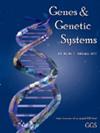利用Asip核基因组序列推断家鼠腹侧毛色变异起源的系统发育地理学研究。
IF 1
4区 生物学
Q4 BIOCHEMISTRY & MOLECULAR BIOLOGY
引用次数: 0
摘要
家鼠广泛分布在欧亚大陆,在包括日本群岛在内的一级和二级分布区,家鼠的毛色在当地种群之间和内部都有很大的变化,但人们对这种颜色变化的进化史知之甚少。为了解决腹侧皮毛颜色的变化,我们量化了博物馆皮肤标本的亮度,发现南方亚种M.castaneus(CAS)在干旱和多雨的地理区域分别具有高亮度和低亮度。北方亚种M.M.musculus(MUS)在欧亚大陆北部的高纬度和中纬度分别具有低亮度和高亮度。我们检测了agouti信号蛋白基因(Asip)的序列变异,已知该基因与腹侧毛色有关。我们对之前报道的98只野生小鼠的全基因组数据进行了分阶段分析,产生了196个Asip单倍型序列(~180kb)。网络和系统发育树的构建揭示了代表MUS和CAS两个亚种的单倍型的聚类。亚种群中出现了许多具有地理亲缘关系的亚群,其中基本结果与用线粒体全基因组数据重建的结果一致,表明核基因组的阶段性单倍型基因组序列可以成为追踪地理谱系分布的有用工具。系统地理学分析结果表明,具有深色腹毛的CAS小鼠在整个地理分布中具有相似的Asip单倍型,这表明这些单倍型是历史上从印度北部向包括日本群岛在内的周边地区引入深色腹毛Asip单倍型的主要原因。同样,东亚的MUS有一个白色的腹部,与伊朗北部的MUS形成了一个同样有白色腹部的Asip单倍群。本文章由计算机程序翻译,如有差异,请以英文原文为准。
Phylogeographic study using nuclear genome sequences of Asip to infer the origins of ventral fur color variation in the house mouse Mus musculus.
While the house mouse (Mus musculus), widely distributed in Eurasia, is known to have substantial coat color variation between and within local populations, in both primary and secondary distribution areas, including the Japanese archipelago, the evolutionary history of the color variation is poorly understood. To address the ventral fur color variation, we quantified the lightness of museum skin specimens, and found that the southern subspecies, M. m. castaneus (CAS), has high and low lightness in dry and rainy geographic regions, respectively. The northern subspecies, M. m. musculus (MUS), has low and high levels of lightness in the high and middle latitudes of northern Eurasia, respectively. We examined sequence variation of the agouti signaling protein gene (Asip), which is known to be responsible for the ventral fur color. We performed phylogenetic analyses with 196 haplotype sequences of Asip (~180 kb) generated by phasing the whole-genome data of 98 wild mice reported previously. Network and phylogenetic tree construction revealed clustering of haplotypes representing the two subspecies, MUS and CAS. A number of subclusters with geographic affinities appeared within the subspecies clusters, in which the essential results were consistent with those reconstructed with whole mitochondrial genome data, indicating that the phased haplotype genome sequences of the nuclear genome can be a useful tool for tracing the dispersal of geographical lineages. The results of phylogeographic analysis showed that CAS mice with darker ventral fur possessed similar Asip haplotypes across the geographic distribution, suggesting that these haplotypes are major causes of the historical introduction of Asip haplotypes for darker ventral fur in mice from northern India to the peripheral areas, including the Japanese archipelago. Similarly, MUS in East Asia, which has a white abdomen, formed an Asip haplogroup with that from northern Iran, also with a white abdomen.
求助全文
通过发布文献求助,成功后即可免费获取论文全文。
去求助
来源期刊

Genes & genetic systems
生物-生化与分子生物学
CiteScore
1.50
自引率
0.00%
发文量
22
审稿时长
>12 weeks
期刊介绍:
Genes & Genetic Systems , formerly the Japanese Journal of Genetics ,
is published bimonthly by the Genetics Society of Japan.
 求助内容:
求助内容: 应助结果提醒方式:
应助结果提醒方式:


